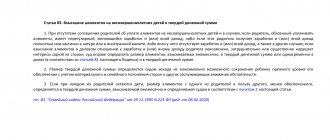When parents divorce and most often the child remains to live with his mother, not every father continues to support and raise him. This responsibility falls on the shoulders of the parent with whom the child lives after the divorce, although according to the law (Article 80 of the RF IC), responsibility for maintaining a minor dependent should be distributed equally between the mother and father. When an unscrupulous father ignores the requests of his ex-wife in favor of financial support for the child, she has to go to court to force the collection of alimony.
It seems that the problem has been resolved, however, even after a court decision on alimony payments was made, the father continues to evade parental obligations or does so irregularly. And according to the legislative framework, such acts are subject to administrative liability in the form of a fine and payment of a penalty. However, not every mother knows how to calculate the penalty for alimony and what to do if a large amount of debt arises.
What is a penalty for alimony?
A penalty for alimony is a type of fine imposed if the alimony payer dishonestly fulfills his obligations to timely pay financial assistance to the child in accordance with a court writ of execution or a notarial agreement. In other words, a penalty is a penalty that is charged for each day the debt is formed (0.5% per day). That is, the larger the amount of debt, the higher the amount of the penalty will be; accordingly, if it is not repaid on time, the alimony debt will grow much faster.
The accrual of a penalty of 0.5% for each subsequent day for non-payment of alimony is determined by Article 175 of the Family Code.
What is it: concept
According to family law, parents are obliged to financially support their minor and disabled children. An agreement between the parents or a court decision determines the amount and procedure (term) for transferring funds. Evasion of timely payment of alimony, violation of the established conditions for their transfer leads to the appearance of debt , which is why a penalty (fine) is charged.
A similar obligation falls on children when their parents reach retirement age (clause 1 of Article 87 of the RF IC).
A penalty is a fine that is assessed if a person does not fulfill obligations to support close relatives, whether children or parents. If, as a result of dishonest payment of alimony, the recipient suffers losses, he may demand compensation for them.
The amount of the penalty is calculated using the formulas below . They are given for cases in which the procedure and amount of payments are determined by a court decision or an agreement between spouses. A mandatory condition in the contract between spouses is that it be certified by a notary.
There are situations in which the payer voluntarily transfers alimony without resorting to court proceedings and without entering into an agreement with the child’s mother. If there is a delay, it will not be possible to charge a penalty in this case. Instead, you can request child support payments for the last three years. This method of influence is allowed if the payer dishonestly fulfills obligations for the material maintenance of the child.
Online calculator for calculating alimony penalties
Enter debt parameters
| Insert debt data | Data import instructions 1. Copy the data from the editor (as in the picture). Pay attention to the order of the columns : date, amount 2. Paste the data into the field on the left 3. Click "Insert" |
| Insert payment details | Data import instructions 1. Copy the data from the editor (as in the picture). Pay attention to the order of the columns : date, amount 2. Paste the data into the field on the left 3. Click "Insert" |
Calculation result:
Permanent link to the calculation results: Copy link
| Debt: | rub. | Beginning of period: |
| Percent: | End of period: |
Copy table | Print table | Copy link
Can't collect child support? We will help!
The principle of operation of the calculator is to automatically calculate the debt according to the monthly amount of alimony and the number of days of delay in payment. Based on the entered data, the calculator multiplies the number of days of delay by the established penalty (by default), determined by the norms of the Family Code. It is very important to enter the required information correctly here.
How to calculate a penalty using a calculator
Before you start making online calculations, you should understand that the calculator cannot calculate the entire amount of debt, for example, for six months. It makes calculations for each individual month. Before you begin, please read the basic rules for entering data:
- Enter the date when the debt began to form, that is, the day when the father did not transfer the monthly amount of alimony according to the writ of execution.
- Next, enter the amount of alimony you should have received for this month.
- In the “Percentage” field, enter the established penalty. If alimony is paid by court decision, then by default leave 0.5%, and if you determined the amount of the penalty yourself when signing a notarial agreement on alimony, then enter a different figure.
- Be sure to indicate the end date, that is, for how many days to calculate the penalty.
- Also, the calculator can independently calculate the difference, subject to conditions, if part of the debt was paid during a given period.
The calculator works on the basis of the established rules for calculating penalties given in Article 115, Part 2 of the Family Code.
The only disadvantage of this method of calculation is that using a calculator you have to determine the debt for each specific month separately, because the amount of alimony depends on the father’s earnings. That is, in order to find out the total amount of the debt, for example, if the alimony payer has already been in debt for more than 4 or 5 months, then it is necessary to calculate each individual period, and then add up the resulting values. This will be the total amount of debt over a long period.
How are penalties determined?
The penalty begins to accrue from the first day of the next month...
The accrual of penalties begins from the first day of the month following the one in which the monthly regular payments were fully and timely settled.
!!! Check the correctness of alimony payments with the Alimony Calculator
Grounds for receiving a penalty
Before you start calculating the penalty, first familiarize yourself with when you can demand repayment of not only the debt, but also the penalty.
In what cases is a penalty collected?
Below is a list of grounds that must be met in order to legally demand payment of debts and penalties:
- the collection of alimony has legal force, that is, this decision is recorded in a judicial writ of execution or in a voluntary agreement between parents certified by a notary;
- the court granted the mother’s application for calculation and penalty;
- if a debt has arisen, then the document on the collection of alimony and penalties must be handed over to the bailiff. And he, in turn, applies coercive measures to the debtor to pay off the total debt;
- the debt arose due to the payer’s fault without good reason.
In what cases is the penalty not collected?
Now we need to consider situations when the court may reject your request to accrue a penalty for alimony:
- the debt arose for good reasons, for example, the alimony payer was fired from work or temporarily lost his ability to work;
- when the non-transfer of funds was not due to his fault, for example, the company’s accounting department did not make the necessary deductions from the alimony payer’s salary or the payment was frozen due to negligence or operational errors of the banking system;
- the writ of execution for the collection of alimony was not transferred to the bailiff service;
- when it was not possible to pay alimony as a result of circumstances beyond the payer’s control, for example, an emergency, natural disasters, etc.
As for the lack of timely alimony payments due to the fault of the alimony payer, if their delay has valid grounds, he needs to confirm this. Typically, confirmation is a certificate from work, a bank or a medical institution.
Form of alimony
The law and judicial practice stipulate that alimony can be paid:
- in kind - material and intangible benefits are provided: clothing, food, recreation and leisure are organized, housing is provided;
- money.
Question: The organization that booked a room for a posted worker, in accordance with the contract, transferred to the hotel the amount of damage caused by the guest. Can an employer recover damages from an employee if, by a court decision, he is already withheld 70% of his wages in the form of child support? View answer
Alimony in money will be awarded to:
- In hard form - they will determine a clear amount.
- In share - in part of a person’s income.
Funds are forcibly withheld only from the debtor’s official income. Otherwise (if voluntary performance) he would not be a debtor and would support his relative himself, incl. and from unofficial income.
Question: An accountant mistakenly withheld a larger amount of alimony from an employee’s salary. The error was discovered after payments under the writ of execution were stopped. The recipient of alimony refuses to return the money voluntarily. Is alimony that was erroneously transferred in a larger amount subject to refund? Does an employee have the right to recover from the employer the amount of alimony and interest that was excessively withheld from wages? If so, does the employer, in turn, have the right to recover damages from the accountant? View answer
Amount of penalty for alimony
Regardless of how alimony is collected - through the court or voluntarily, the penalty begins to accrue from the first day of the next month, if the amount has not been transferred earlier.
Amount of penalty under the contract
The agreement implies the conclusion of a voluntary agreement on the payment of alimony, which is certified by a notary to give it legal force. This agreement specifies:
- amount of alimony;
- collection procedure;
- methods of obtaining;
- duration of the agreements;
- payment form;
- liability of the parties, including the accrual of penalties.
When concluding a notarial agreement, the amount of the fine is set at the discretion of both parties and can be more than 0.5%. To collect it, you must go to court with a signed agreement.
Amount of penalty according to law
By law, the amount of the penalty is fixed in the Family Code: Article 115. As we have already said, the penalty is equal to 0.5% for each overdue day of the total debt. Bailiffs are forced to pay the penalty based on a court decision. Penalties accrue until the debt is repaid in full. In addition, if the debt has accumulated over several years, then the statute of limitations for such cases is 3 years and you can file a lawsuit to collect the debt even after the child turns 18 years old.
Further actions
The resulting calculations are used for pre-trial settlement of the dispute or are included in the text of the statement of claim when going to court. In the first case, the size of the penalty and its subsequent growth have a convincing effect on the payer, encouraging him to voluntarily pay the debt as soon as possible.
If this does not happen, the dispute is taken to the courtroom . To do this, a claim is drawn up, in which, in addition to the name of the court, passport details of the defendant and plaintiff, the following is entered:
- Documents of title on the basis of which obligations to pay alimony arose, when and by whom they were issued.
- Facts of dishonest fulfillment of obligations by the payer.
- Results of pre-trial dispute resolution.
- The amount of the penalty and its calculation.
- Links to the norms of current legislation.
- Claim.
- List of additions to the claim, including copies of title documents.
- Date and signature.
The prepared claim with attached documents is sent by mail or submitted through the office of the magistrate judge . In the first case, a check and an inventory of the investment remain in hand, in the second - the date and signature of acceptance of the application, which are affixed by an authorized person.
Read more about the rules for drawing up an application for alimony penalties here.
Deadlines
The statute of limitations for a debt within the framework of a current agreement or a court decision that imposed alimony is not established by law. Even an adult child who does not have the right to collect alimony can go to court and demand it if he has not received it before. The claim (or claim against the payer) must be filed before the child turns 21 years old. In this case, the three-year limitation period for debt collection is observed.
The period may be increased if the court finds that the child’s parent has evaded his obligations to pay child support. The court may decide to pay alimony for the entire period, and not just for three years.
Who calculates alimony penalties?
Just like that, according to your decision, as well as the calculations made, you cannot force the debtor to pay the penalty. This is done by the bailiff service, but only after a court decision has been made. If the court has granted the request for a penalty, the bailiff makes a calculation, and then takes enforcement measures to collect the debt from the alimony payer. To do this, the bailiff has information about the debtor’s place of work, as well as whether he has property.
When making a decision on forced collection of both debt and penalties, the court can rely only on the information of the bailiff, but not on the plaintiff’s independent calculations.
You can learn how to calculate the penalty using formulas established by law, just at least for the purpose of understanding how it works in practice, and also so as not to contact the bailiffs once again if you want to know the approximate amount for the past period, especially if the payer regularly violates deadlines .
Practice of resolving cases under Article 115 of the RF IC
In April 2021, the Moscow District Court considered the claim of the alimony payer against the recipient and the bailiff. The applicant's demands are to suspend enforcement proceedings against him. Thus, the plaintiff did not agree with the bailiff’s determination of the amount of debt under Article 115 of the RF IC, and considered it necessary to suspend the collection of his wages and other income.
For a detailed study of judicial practice on the collection of penalties, we recommend reading a separate material.
During the court hearing, it became known that Podolsk ROSP initiated enforcement proceedings against the plaintiff in order to collect alimony in the amount of 25% of total income. The applicant does not agree with the calculations made by the bailiff and believes the following :
- The period when the plaintiff lived with the recipient of the money as one family and actually supported the child was not taken into account.
- For this reason, the amount of alimony debt and penalties must be reduced.
The court found that the decision to determine the debt was made during the execution of the decision to collect funds for the financial support of the child. The plaintiff did not challenge this decision either in the past or at the time of consideration of this claim, therefore the bailiff had no grounds for releasing the debtor from paying the funds. On this basis, the plaintiff's claims cannot be satisfied.
Formulas for calculating alimony penalties
Now let's move directly to the calculations. To do this, you need to use one of the formulas. Remember that if the father partially contributed small amounts of alimony debt, then they will need to be subtracted from the resulting figure at the end. If the debt has accumulated over several months, then it is better to sometimes come to the bailiff service and compare their data with yours so that there are no discrepancies.
Formula for calculating penalties for a month
Total amount of debt * number of days in a month * % of the penalty.
Formula for calculating penalties for a specific period
Amount of debt for a certain month * number of overdue days * % of the penalty.
Examples of calculating penalties for alimony
For a better understanding, it is better to consider the presented formulas using an example.
Example 1
The father stopped paying child support in March. Today is the month of June. Alimony payments were established by the court in a fixed form in the amount of 6,000 rubles. So, the calculation of the penalty will be as follows:
- March = 6000*31 days*0.5% = 930 rubles.
- April = (6000+6000)*30 days*0.5% = 1800 rubles.
- May = (6000+6000+6000)*31 days*0.5% = 2790 rubles.
Total: 930+1800+2790=5520 rubles - penalty for 3 months, or 23,520 rubles - total debt with penalties.
Example 2
Child support is paid in proportion to the father's salary. Based on the income of the child support payer, the child should have received 10,000 rubles in January, 9,200 rubles in February, and 9,800 rubles in March. However, the established amounts never arrived. In this case, the calculations will be as follows:
- January: 10000*31days*0.5% = 1550 rubles.
- February: (10000+9200)*28 days*0.5% = 2688 rubles.
- March: (10000+9200+9800)*31day*0.5% = 4495 rubles.
Total: the penalty for the entire period of delay is 8,733 rubles, and the total debt with penalties is 37,733 rubles.
If you are going to file a lawsuit to force collection of debt, then before providing the data from the online calculator, it is better to check the received data with the bailiff’s certificate, and then attach the document to the statement of claim. Remember that the alimony payer can be held accountable for late payment of alimony only if he has no good reason for doing so. In such a difficult matter, it is best to seek the help of an experienced lawyer.









